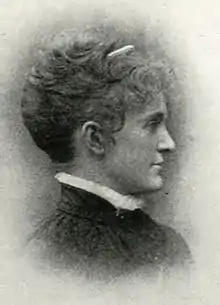Louise Lawson
Louise Lawson (1860s - April 5, 1899)[1] was a Neoclassical sculptor and one of the first American women sculptors to have a professional career.


Family and education
Louise Lawson was born in Cincinnati, Ohio, the daughter of L. M. Lawson, dean of the Medical College of Ohio.[2][3] Her mother died when she was young, and her father educated her himself instead of sending her to school.[2] She developed her interest in art early and got her art training at the Art Academy of Cincinnati with Louis Rebisso and Thomas Satterwhite Noble and then in New York at Cooper Union and with sculptor John Quincy Adams Ward.[2][4][5] She then went abroad for three years of study in Paris with Auguste Rodin, on whose advice she went to Rome and Perugia for a further three years of study.[2][4][5] Her first known work, Il Pastore, was made in Rome.[5]
Art career
On her return to the United States in the late 1880s, Lawson opened a sculpture studio in New York.[2] With exhibitions and commissions beginning in the 1880s, she was one of the first American women sculptors to have a professional career.[6] She worked in a Neoclassical style in both marble and bronze, and her sculpture was often compared to that of Harriet Hosmer, who also studied in Rome.[4][7] Her career was truncated as she was still in her 30s when she died.
Her best-known work is an 1891 bronze memorial sculpture of Congressman Samuel S. Cox. Originally placed near his home on the Lower East Side, it now stands in Tompkins Square Park.[6][8] It depicts Cox orating and has been criticized as a poor likeness.[8]
Two of her marble pieces have literary origins: Ayacanora is a life-size statue of the Indian heroine of Charles Kingsley's 1855 novel Westward Ho!, while The Origin of the Harp refers to a poem of the same title by the Irish poet Thomas Moore.[7] Another marble work, The Rhodian Boy is an homage to Classical sculpture.
In 1886, one of her marble sculptures, The Shepherd, was ruined when the ship bringing it from Italy to the United States, the French steamship Burgundia, sank after a collision with the Italian man-of-war Italia in the Bay of Naples.[7]
A bronze relief of a fencer was installed at the New York Athletic Club in 1890.[9]
Notable sculptures
- Il Pastore (early 1880s)
- Ayacanora (mid 1880s)
- The Origin of the Harp (mid 1880s)
- The Rhodian Boy (mid 1880s)
- Samuel S. Cox (1891)
References
- "Louise Lawson Passes Away at New York — Had a Number of Relatives in This County." Evening Bulletin (Maysville, Kentucky), April 7, 1899.
- Willard, Frances E., and Mary A. Livermore. A woman of the century: Fourteen hundred-seventy biographical sketches accompanied by portraits of leading American women in all walks of life. New York: Moulton, 1893, pp. 452-53.
- Willard, Frances E., and Mary A. Livermore. A woman of the century: Fifteen hundred biographical with Over 1,400 Portraits: A Comprehensive Encyclopedia of the Lives and Achievements of American Women During the Nineteenth Century, vol. 2. Springfield, Ohio: Mast, Crowell & Kirkpatrick, 1897, pp. 451-52.
- Southworth, Alvan S. "The Sculptors of New York". Frank Leslie's Popular Monthly, 25:2 (February 1888), pp. 141-42.
- "Louise Lawson". The Illustrated American, vol. 4, Oct. 18, 1890, p. 185.
- Wirth, Carolyn. "Louise Lawson". To Work As a Sculptor, Sept. 3, 2010.
- "Art and Artists Abroad: The Return of Miss Louise Lawson". New York Times, Oct. 18, 1887.
- "Tompkins Square Park: Samuel Sullivan Cox". New York City Department of Parks & Recreation website.
- "Sayings and Doings of Women". Good Housekeeping vols. 10–26 (Nov. 9, 1889 – April 26, 1990), p. 283.